Those White House Christmas decorations don't magically appear. This is what it takes.
You think your holiday season is hectic? For the hardworking staff that serves the president and his family, holidays at the White House mean long hours of advance planning and months of behind-the-scenes preparation, culminating with spectacular results that the first family and 100,000 visitors get to enjoy at parties, receptions, public tours and open houses.
In the White House’s earliest days, the residential staff decked rooms with cedar and holly, cooked feasts with cakes and punch, and built fires against the winter cold. Their modern heirs plan and pull off lavish, intricately planned holiday festivals with world-class decorative arts, confections, flowers and lighting.
The work often begins as soon as February, when design ideas are presented to the first lady for consideration. These decisions will influence thousands of decorations and ornaments found on the White House Christmas tree in the Blue Room and every surrounding public room.
Jacqueline Kennedy was the first first lady to organize Christmas decorations around a theme, choosing the "Nutcracker Suite" in 1961.
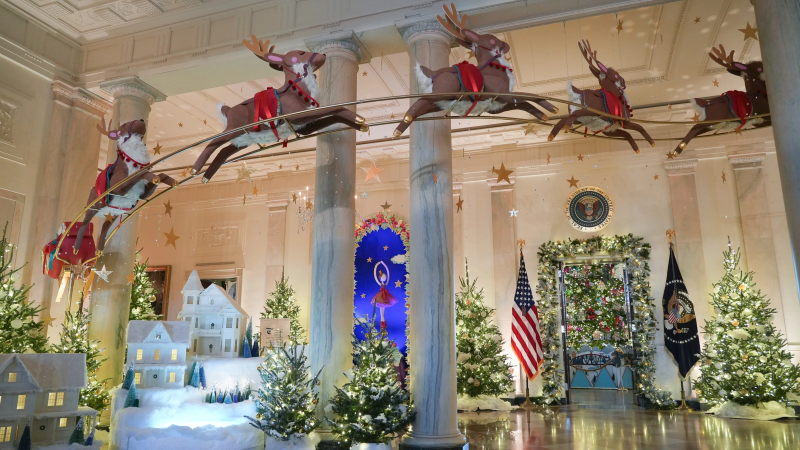
White House Christmas themes means busy time for staff
Other first ladies have highlighted early Americana, handmade crafts, Victorian toys, needlepoint, children’s nursery rhymes and books, service members and American treasures.
Laura Bush’s 2002 “All Creatures Great and Small” theme featured papier-mâché replicas of presidential pets, including Abraham Lincoln’s pet goats, Woodrow Wilson’s tobacco-chewing ram, Theodore Roosevelt’s family macaw and Caroline Kennedy’s pony Macaroni.
Christmas and Hanukkah celebration:The evolution of holidays at the White House
Once the theme is chosen, the chief usher works closely with the first lady to oversee months of preparations by carpenters, plumbers, electricians, florists, cooks and pastry chefs. Ribbons and other materials have to be ordered early. Craftspeople and painters begin working on thematic ornaments made from natural plant materials, paper, fiber, ceramics, metal and wood.
Holiday baking begins as early as June, after gathering the nuts and candied fruits necessary to make half a ton of fruitcakes (which mature properly after being refrigerated for months). Dough for thousands of cookies is made with chocolate, glazed fruits, maple sugar, coconut and freshly ground spices, then frozen to be baked fresh throughout the season.
The pastry chefs also begin to create thousands of marzipan and sugar decorations, including Santas, presidential pets, teddy bears and snowmen wearing colorful hats and scarves. As fall approaches the chefs turn to stollen, panettone and banana, carrot and pumpkin cakes.
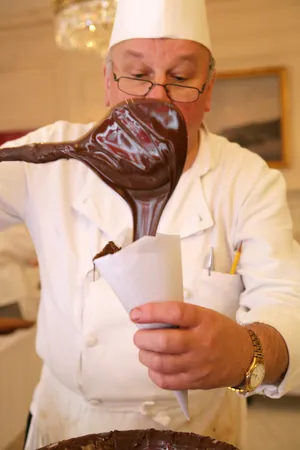
At every step of the decorative process, details matter: the color of the lights in every room, how flowers coordinate with the furniture, and just-right bow sizes and ribbon colors. The floral staff − with the help of volunteer florists from around the country − weave handmade garlands, place berries on fresh wreaths and assemble ornamental arrangements for the East Room. Mistletoe is tied with ribbon, and wreaths are prepared to hang in front of gilded mirrors.
In the kitchen, it’s time to make the gingerbread house to display in the State Dining Room. What began with a simple A-frame design under first lady Patricia Nixon has become a sugary showpiece drawn from blueprints and historic photographs, with windows and doors made to scale.
This year’s house weighed in at more than 300 pounds, requiring 80 sheets of dough, 90 pounds of sugar paste, 30 pounds of chocolate and 50 pounds of royal icing.
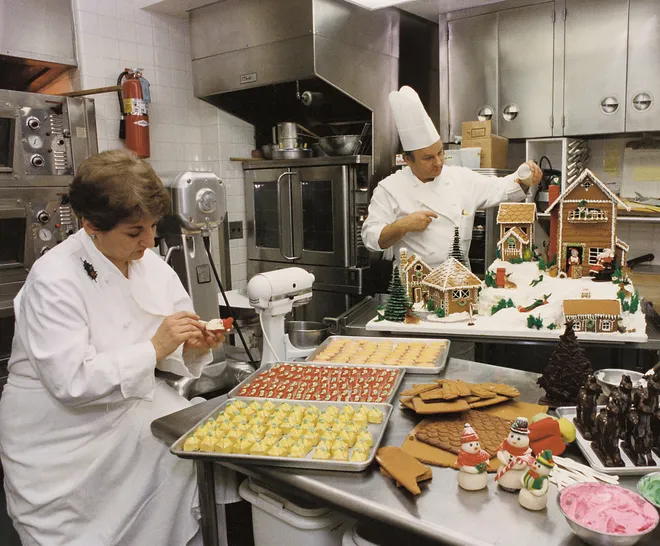
The arrival and decoration of the Christmas tree
As Thanksgiving approaches, the White House Christmas tree is delivered to the North Portico in a horse-drawn wagon that marks the official beginning of the White House holiday season. Selected by the chief usher in a nationwide competition, the tree (typically a fir) is trimmed to exactly 18½ feet, and its shape and layering of branches must be just right.
A Blue Room chandelier is removed to make room, and National Park Service workers haul the tree in to be hoisted into a custom-built stand that holds 15 gallons of water. White House electricians string thousands of lights.
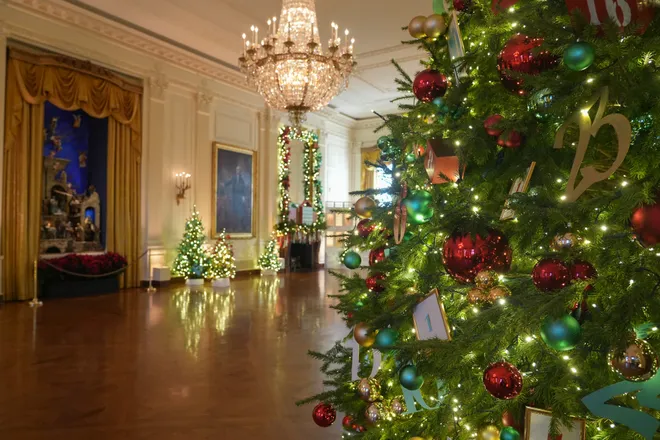
Hundreds of volunteers assemble the day after Thanksgiving to help decorate, working through the weekend to hang thousands of ornaments.
Over the years, homemade ornaments have been donated by makers as diverse as artisans, architecture students, needle pointers, Peace Corps volunteers, the Society of Decorative Painters and third graders hand-cutting paper snowflakes.
Ornaments from the White House Historical Association have been added since the 1980s.
The unsung heroes of the volunteer staff
This year’s volunteer decorators also decked the White House halls (and 97 other Christmas trees) with more than 140,000 lights, hung garland from marble columns, strung letters to Santa, mounted giant cloth cupcakes and pinwheel lollipops on columns and archways, and set lights and metallic balls and berries over the entranceway greenery.
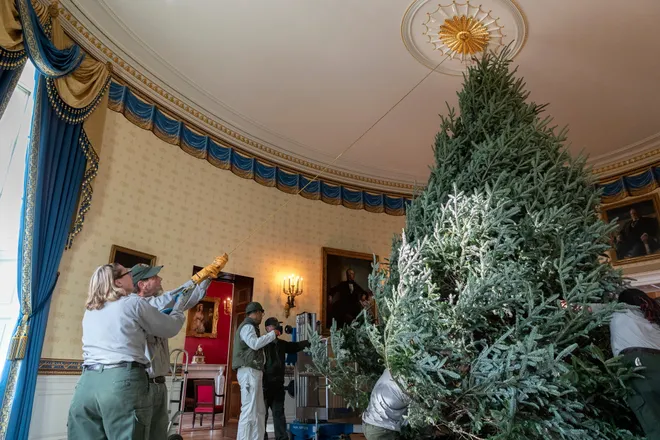
They affixed nearly 34,000 ornaments, 15,000 feet of ribbon and more than 22,000 bells.
A first lady mourns:Jackie Kennedy mourned her husband while comforting a nation. 'What if I hadn't been there?'
When visitors arrive to see the holiday extravaganza, they are greeted by volunteer staff and serenaded by student and military bands and choirs. At receptions, staff refresh food, pastries and drinks.
For the White House staff, extraordinary dedication to making the holiday special is all in a day’s work. In December 1980 a skating rink was erected on the South Lawn, where Olympic gold medalist Peggy Fleming came to perform. As temperatures plunged during a nighttime show, White House butler Alan DeValerio kept his freezing hands warm for duty by pouring hot chocolate over them when no one was looking. A South Lawn rink has been reinstalled this year.
As we gather with family and count the blessings of friends this holiday, I hope that the remarkable behind-the-scenes labor of the White House staff will help us all better understand and appreciate the workers around us who labor to make our holidays special, and every other day of the year.
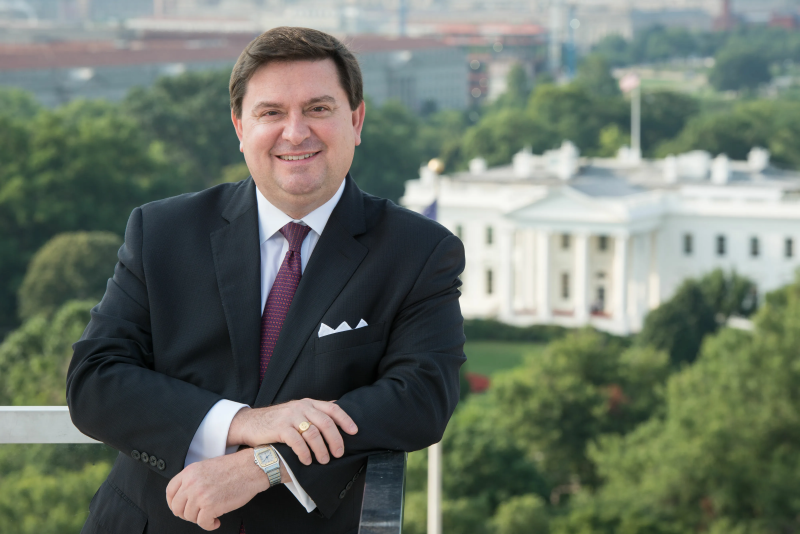
Stewart D. McLaurin is president of the White House Historical Association, a private nonprofit, nonpartisan organization founded by first lady Jacqueline Kennedy in 1961. The association also sells theannual White House Christmas ornament. All proceeds help fund the acquisition of furnishings and artwork for the White House permanent collection, assist in the preservation of the historic rooms and educate the public on the history of the White House.
Disclaimer: The copyright of this article belongs to the original author. Reposting this article is solely for the purpose of information dissemination and does not constitute any investment advice. If there is any infringement, please contact us immediately. We will make corrections or deletions as necessary. Thank you.







